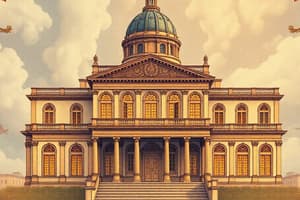Podcast
Questions and Answers
What powers and responsibilities are given to the legislative branch of government?
What powers and responsibilities are given to the legislative branch of government?
The legislative branch is responsible for the creation of laws, declares war, regulates interstate and foreign commerce, and controls taxing and spending policies.
How are laws and public policy created?
How are laws and public policy created?
Laws and public policy are created through agenda-setting, option-formulation, and implementation.
What are the benefits and drawbacks of having a two-branch legislature?
What are the benefits and drawbacks of having a two-branch legislature?
Benefits include stability and more varied representation; drawbacks include deadlock and unequal representation.
What powers and responsibilities are given to the executive branch?
What powers and responsibilities are given to the executive branch?
What powers are given to the judicial branch?
What powers are given to the judicial branch?
How is the US court system organized?
How is the US court system organized?
How do the three branches work together to create public policy?
How do the three branches work together to create public policy?
How does each of the three branches check each other?
How does each of the three branches check each other?
Flashcards are hidden until you start studying
Study Notes
Legislative Branch Powers and Responsibilities
- Responsible for creating laws and overseeing public policy.
- Powers include declaring war, regulating commerce, and controlling taxation and spending.
Creation of Laws and Public Policy
- Public policy shaped by education, advocacy, and interest group mobilization.
- Typically follows three steps: agenda-setting, option-formulation, and implementation.
- Agenda-setting involves discussions among agencies and officials to identify problems.
- Option-formulation involves considering alternatives and deciding on the best policy.
- Implementation is the final stage where the approved policy is executed.
Two-Branch Legislature: Benefits and Drawbacks
- Advantages: stability, diverse representation, higher quality legislation.
- Disadvantages: potential for deadlock and unequal representation.
- Stability arises from checks and balances between two legislative houses, preventing majority rule oppression.
Executive Branch Powers and Responsibilities
- Main responsibility is law enforcement.
- Headed by the President of the United States.
- The President must balance enforcement of laws without overstepping authority of other branches.
Judicial Branch Powers
- Headed by the Supreme Court.
- Powers include interpreting the Constitution, reviewing laws, and adjudicating cases involving states' rights.
Organization of the U.S. Court System
- Comprises two systems: federal and state courts.
- Federal courts include the U.S. Supreme Court, U.S. Courts of Appeals, and U.S. District Courts.
- State court systems handle the majority of cases and include municipal and county courts.
- The Supreme Court serves as the highest court with final law interpretation.
Collaboration Among the Three Branches
- Legislative process requires both the House and Senate to pass a bill.
- Once passed, the bill moves to the executive branch for presidential approval.
- Judicial branch can declare any law unconstitutional if deemed necessary.
Checks and Balances Among Branches
- Established by the Constitution to prevent concentration of power in any single branch.
- President can veto congressional laws; Congress can override vetoes with a two-thirds vote.
- The Supreme Court has the authority to declare laws unconstitutional but requires presidential nominees approved by Congress for judicial appointments.
Studying That Suits You
Use AI to generate personalized quizzes and flashcards to suit your learning preferences.




